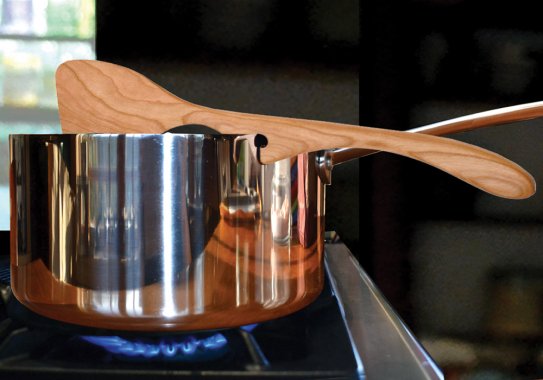Jonathan’s Spoons
Jonathan’s Spoons
Life sometimes has a sweet serendipity, a flow of events that starts by happenstance and plays out over time into something pretty big. Case in point: the evolution of the Lazy Spoon.
It’s 1977, and Jonathan Simons, a young woodworking apprentice, is about to pop open the thermos of homemade vegetable soup he’s brought for lunch, when he realizes he forgot a spoon. So he takes 10 minutes and makes one out of wood. Without knowing it, he’s launched a career.
Jump ahead to 1999, by which time Simons has carved out a successful niche for himself as a maker of fine wooden spoons. At a craft fair, a prospective customer stops by his booth, pokes through his box of flawed, misshapen odds and ends, picks up a spoon with an unintended notch in the handle, and asks what it’s for. Almost as a joke, Simons answers by fitting the notch to the edge of the box. The spoon balances perfectly there, he has an epiphany, and a new product is born: his bestselling Lazy Spoon, ingeniously designed to sit on the rim of a bowl or pot as you cook. Now fast-forward to 2005. One of Simons’ fans attends a book signing by TV cooking maven Rachael Ray and gives her a Lazy Spoon. Ray is wowed and shows one on the Oprah Winfrey Show. Oprah is wowed, too, and so are her viewers, who crash Simons’ website with 4,000 retail orders in one week. He ends up doubling his business, just in time for the explosion of the artisanal movement and foodie culture.
“It’s all about how it connects the human with the food,” he says of his artful implements, which include pie servers, spatulas, ladles, salad sets: just about every imaginable form for stirring, scraping, and scooping.
Simons, 64, has always felt a strong connection between handwork and spirituality. He grew up in the Philadelphia suburbs, where his father was pastor at the Bryn Athyn Cathedral, a formidable Gothic structure filled with beautiful woodwork that Simons remembers admiring as a child. “The doors, in particular, for me had a flow to them that was just so wonderful to touch,” he says. After majoring in art and design at the University of Illinois, he came back to Pennsylvania and eventually set up his woodshop in Kempton, not far from his hometown.
Today he works with a half-dozen craftspeople to produce his designs in wild cherry, cutting them on a bandsaw and then sanding them to a buttery smoothness. He maintains another shop at his house – “a log cabin on a little mountain in the woods” – where he uses a laser to carve MoonSpoon, a newer line featuring decorative motifs designed by both him and his wife, Julia. The couple has five grown children, several of whom work in the business.
His secret to success? Simons advises young craftspeople to pay equal attention to the process of making and to making the object useful. “It’s important to love both,” he says. Every pursuit, he notes, has a “love side” and a “truth side.” His love is for the wood itself and the sounds and smells of the shop. His truth is form, the understanding and skill that goes into making a functional object.
For Simons, love and truth line up with another pair of values he cherishes. “With creativity, you have freedom and discipline,” he says. “When you put the two together, you get accomplishment.”
Stir Crazy
Finishing touch: In junior high, Simons made wooden objects in shop class for his blind grandmother. “She would feel them and say, ‘Oh, needs more sanding here.’ ” It’s how he learned to give his pieces a smooth finish.
Tooling around: Simons likes wielding and modifying tools in offbeat ways – a drill press on an angle or a sander positioned backwards. To sand the bowls of his spoons, he uses his high-school lacrosse ball, mounted on a motor.
Spoon swoon: People tend to collect his pieces one at a time. “At every show, they’ll say, ‘Well, I’m here to get my spoon for the year.’ That’s really fun. My favorite is when one customer says to another, ‘Oh, you’ve got to get one of these.’ ”


